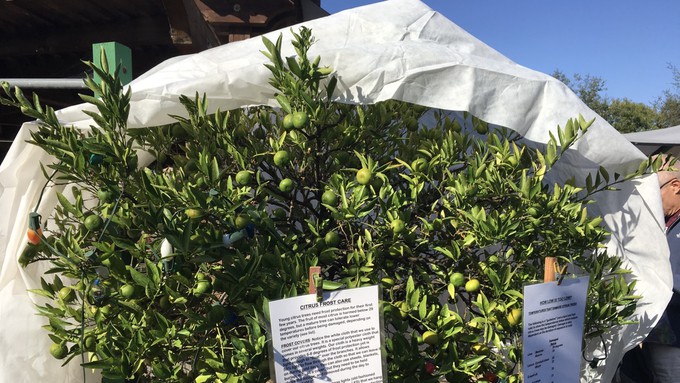
Overnight lows near freezing put poinsettias at risk

This display by the Sacramento County master gardeners shows how to protect a young citrus tree with frost cloth and/or old-fashioned Christmas lights. In practice, the cloth would be pulled completely over the tree on all sides. Kathy Morrison
According to the National Weather Service, Sacramento and its surrounding areas can expect areas of frost in the early hours of the morning Saturday through Tuesday. We’re officially under a frost warning from 11 p.m. Friday through Saturday morning.
Overnight lows are expected to dip into the low 30s every night from Friday through Tuesday.
“Near to below freezing overnight/morning temperatures will return to the Valley tonight and continue through the middle of next week,” tweeted the NWS Sacramento office on Friday morning. “Be sure to take the necessary precautions to protect pets, plants and people, especially for the vulnerable populations!”
In Sacramento, the lowest temperature currently predicted is 33 degrees in the wee hours of Tuesday morning. That’s not quite freezing, but cold enough to burn the leaves and bracts of tender poinsettias. It also can speed the decay of decorative pumpkins. To avoid damage to either, bring them indoors.
Also provide frost protection for tender new seedlings such as newly transplanted cabbage or lettuce. Slip a plastic milk jug over the whole plant; it becomes an instant mini greenhouse.
Provide protection for succulents or any remaining pepper or tomato plants. They’ll definitely feel the chill.
Bring container plants indoors or put under cover. Use cloth sheets (not plastic) for temporary protection. Make sure to remove these sheets during the day so plants don’t overheat and smother.
Except for succulents, water frost-tender plants in the late afternoon before a chilly night is predicted. That extra moisture raises the soil temperature just enough to avoid frost burn.
For more tips on freezing and frost: https://ipm.ucanr.edu/PMG/GARDEN/ENVIRON/frostdamage.html.
Comments
0 comments have been posted.Sacramento Digs Gardening to your inbox.
Sites We Like
Garden Checklist for week of May 5
Survey your garden after the May 4 rainstorm. Heavy rain and gusty winds can break the neck of large flowers such as roses. Also:
* Keep an eye on new transplants or seedlings; they could take a pounding from the rain.
* Watch out for powdery mildew. Warmth following moist conditions can cause this fungal disease to “bloom,” too. If you see a leaf that looks like it’s dusted with powdered sugar, snip it off.
* After the storm, start setting out tomato transplants, but wait on the peppers and eggplants (they want warmer nights). Pinch off any flowers on new transplants to make them concentrate on establishing roots instead of setting premature fruit.
* Trim dead flowers but not leaves from spring-flowering bulbs such as daffodils and tulips. Those leaves gather energy to create next year's flowers. Also, give the bulbs a fertilizer boost after bloom.
* Pinch chrysanthemums back to 12 inches for fall flowers. Cut old stems to the ground.
* Mulch around plants to conserve moisture and control weeds.
* From seed, plant beans, beets, cantaloupes, carrots, corn, cucumbers, melons, pumpkins, radishes and squash.
* Plant onion sets.
* In the flower garden, plant seeds for asters, cosmos, celosia, marigolds, salvia, sunflowers and zinnias. Transplant petunias, zinnias, geraniums and other summer bloomers.
* Plant perennials and dahlia tubers for summer bloom.
* Don’t wait; plant summer bulbs, such as gladiolus and tuberous begonias.
* Harvest cabbage, lettuce, peas and green onions.